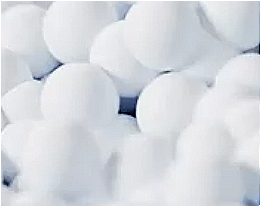Check the ingredients!
... live healthy!


| "Descrizione" by A_Partyns (12876 pt) | 2023-Jul-20 11:25 |
| Evaluation | N. Experts | Evaluation | N. Experts |
|---|---|---|---|
| 1 | 6 | ||
| 2 | 7 | ||
| 3 | 8 | ||
| 4 | 9 | ||
| 5 | 10 |
E442 (Ammonium phosphatides) is a chemical compound, produced by esterification of glycerol and ammonia is used to neutralise the phosphoric acid part.
Ammonium phosphatides refers to a group of substances derived from the reaction of phosphoric acid with ammonia. These substances are often used as emulsifiers in the food industry.
The name describes the structure of molecules.
Description of the raw materials used in their production:
The synthesis process takes place in several stages:
It comes in the form of white granules

Food
Ingredient included in the list of European food additives such as E442 with emulsifying function developed to replace lecithin, in particular in chocolate.
Other uses
Fertilisers, textile industry.
Safety
Ammonium phosphatides (E442) is authorised as a food additive in the European Union (EU) in accordance with Annex II and Annex III to Regulation (EC) No 1333/2008 on food additives and specific purity criteria have been defined in the Commission Regulation (EU) No 231/2012.
Following a request from the European Commission, the EFSA Panel on Food Additives and Nutrient Sources added to Food (ANS) was asked to re‐evaluate the safety of ammonium phosphatides (E442) when used as a food additive.
Toxicological data for ammonium phosphatides were evaluated by the Scientific Committee on Food (SCF) in 1978. The Committee established an acceptable daily intake (ADI) of 30 mg/kg body weight (bw) per day.
Based on the available database, the Panel considered that there is no reason to revise the current ADI for ammonium phosphatides of 30 mg/kg bw per day derived from a NOAEL of 3,000 mg/kg bw per day in the rat carcinogenicity study and applying an uncertainty factor of 100.
References_________________________________________________________________
Colley J and Gaunt IF, 1967. Acute toxicity of Emulsifier YN in rats, mice and rabbits. Submitted by Palsgaard, February 2011.
EFEMA (European Food Emulsifiers Manufacturing Associtation), 2011. Submission of data on emulsifiers, E 442 Ammonium phosphatide ‐ Determination in food, present usage, ADME, subchronic toxicity. Submitted by EFEMA, January 2011.
Mars, 2010. Food Additive (Emulsifier, Stabilisers and Gelling Agents) ‐ Present Usage E 442 Ammonium phosphatides. Submitted by Mars in May 2010.
Palsgaard, 2007. Ammonium phosphatide ‐ Chemistry, Properties, Manufacturing Process, Application in Food. Submitted by Palsgaard, February 2011.
Palsgaard, 2010a. Use levels of certain emulsifiers. Submitted by EFEMA, January 2011.
Palsgaard, 2010b. Recipe suggestion milk chocolate. Submitted by EFEMA, January 2011.
Pre‐evaluation document prepared by the Fraunhofer ITEM. March 2013.
Robbins MC, 1994. A teratology study with emulsifier YN in rats. BIBRA 1331/1. Study from 7 April 1994, 110 p. Submitted by Palsgaard, February 2011.
| Evaluate |